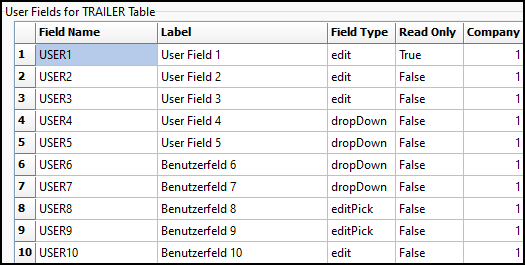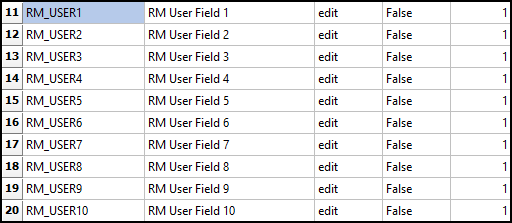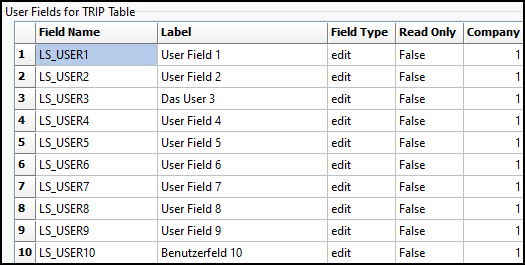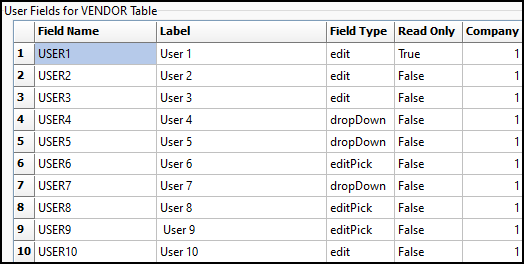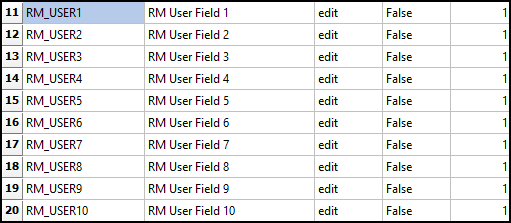TruckMate 2025.1 New Features: Operations
Framework
Open to current template when editing a Dawg (TM-138927)
When you select Choose template while reviewing a Dawg, the template list now opens to the currently assigned template instead of to the top of the list.
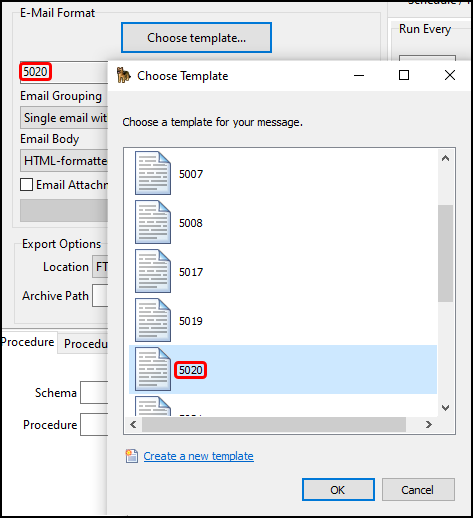
Merged reload options into a single setting (TM-167417)
Each application used to have up to five different refresh options that each refreshed a different part of the system:
-
Configuration Options
-
Security Settings
-
Screen Design
-
DBGrid Setting
-
Quick Filters
These options have been combined into a single menu option, Reload Application Settings.
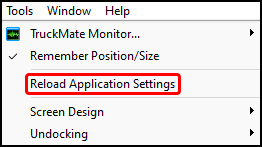
When you select this option, each part of the system is refreshed at the same time.
Added Status column to Miscellaneous Equipment Profiles (TM-168719)
The grid in Miscellaneous Equipment Profiles now has a Status column.

Added bursting to Dawg email grouping options (TM-170730)
You can now use bursting SQL to create an additional condition to choose who will receive the results of a Dawg.
In THE DAWG, there is now a Bursting SQL tab in addition to the standard SQL Statement tab.
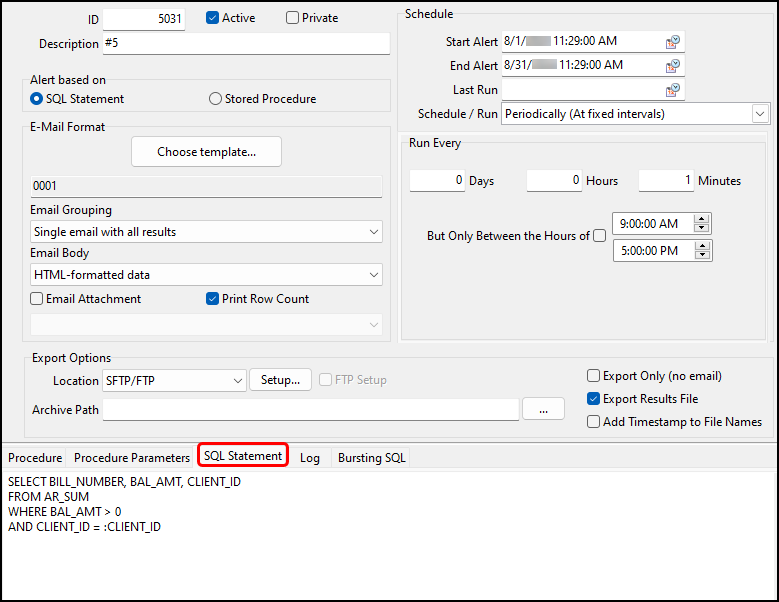

As before, the standard SQL statement pulls a result set that the Dawg requires.
The new bursting SQL can feed additional data into the standard query. It can limit or expand on who will receive the results of the Dawg.
As an example, the standard SQL could be:
SELECT bill_number, bal_amt, client_id FROM ar_sum WHERE bal_amt > 0 AND client_id = :CLIENT_ID
The bursting SQL could be:
select client_id, email from client
In this example, the system will look at AR_SUM and identify any customer who currently has a balance greater than zero. At the end of this statement, there is a condition that looks for CLIENT_ID. That is the standard condition of the Dawg.
The bursting SQL extracts the emails associated with the client IDs.
Put together, the query finds which clients meet this condition and then pulls their email addresses. These can then be put into the template.

Previously, achieving these results required multiple Dawgs or unique code.
|
When you create bursting statements, commented out lines should not be used within the statement. This causes the process to fail. Make sure that commented out lines in the query are removed when you copy entries from KPIs or other Dawgs.
|
Cleaned up Allow Changes Business Events in Security Configuration (TM-172824)
Several Business Events - Allow Changes options have been removed or renamed. The changes do not affect how Dispatch or Multi Mode Dispatch function.
These options have been removed because they were for deprecated applications:
-
AMAN - Allow Terminal Change
-
CROSSDOCK - Allow Create/Edit Trip Schedules
-
CROSSDOCK - Allow Generate Trips from Trip Schedules
-
CROSSDOCK - Allow Terminal Change
These options have been renamed:
-
DISPATCH - Allow Exclusive Freight to Park at Door has been renamed to MMDISP - Allow Exclusive Freight to Park at Door
-
CITYDISP - Allow Create/Edit Trip Schedules has been renamed to MMDISP - Allow Create/Edit Trip Schedules
-
CITYDISP - Allow Generate Trips from Trip Schedules has been renamed to MMDISP - Allow Generate Trips from Trip Schedules
-
CITYDISP - Allow Terminal Change has been renamed to MMDISP - Allow Terminal Change
Removed Macropoint Export license requirement (TM-175864)
Previously, to use the Macropoint Export feature you had to have license 29009 applied to your system. However, this license did not have an associated charge. It is issued via a zero-dollar invoice.
Because of this, the 29009 license check has been removed. It is no longer required to use the Macropoint Export feature.
Validate User ID and User Group on User Import Tool in Security Configuration (TM-177527)
Previously, the User Import Tool allowed you to import information into the TruckMate system that broke character rules for user IDs and group IDs.
To follow these rules, checks are now in place for the User Import Tool:
-
Group IDs can only have:
-
Letters
-
Numbers
-
Underscores (_)
-
-
User IDs can only have:
-
Letters
-
Numbers
-
Underscores (_)
-
Periods (.)
-
If you include a character that does not match these rules, an error opens when you try to import.

Added application version history (TM-178121)
You can now see the version history of any application from the About window.
Go to Help > About in any application and then double-click the application’s name to see its version history.
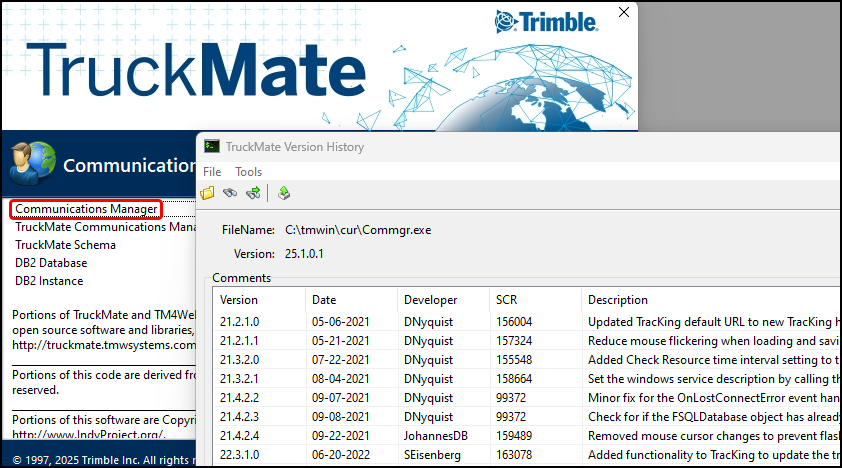
Hid system-based application configuration options (TM-180380)
There are several system-based application configuration options that are not visible to users. These are hidden because changing them can cause major system issues. However, while the options are hidden, their application category still appeared in the list. There were no visible options if you selected the category.

Categories that do not have any visible options no longer appear in the list.

Mileage and mapping
PC*Miler Multi-Version Switcher removed (TM-180206)
Support for Multi-Version Switcher (MVS) has been removed from Mileage Server. All tabs and app configs associated with this feature have been removed.
MVS is a tool that allowed you to run multiple on-premise versions of PC*Miler at the same time without placing each version on different machines. This would then use many open ports to complete mileage transactions.
There are two reasons MVS support has been removed from TruckMate:
-
MVS as a product is no longer sold or supported as of April 1, 2025.
-
Its replacement product, PC*Miler Webservices, is available and already works with TruckMate with the right API key.
If you currently use MVS and plan to upgrade to TruckMate version 2025.1 or higher, reach out to your Customer Success Manager or Trimble Transportation Support about moving to PC*Miler Webservices before you upgrade to avoid any service interruptions.
Ensured Mileage Service ends all sub-processes when service is stopped (TM-180479)
When the Mileage Service was stopped, some of the sub-processes would try to continue processing their current jobs. This prevented those processes from correctly shutting down, resulting in the service hanging.
Now, when the Mileage Server is stopped, all sub-services end correctly.
Mobile communications
Allow mobile communications to recover from DB2 outage (TM-179013)
The MobileComm service can now recover from a DB2 outage without manual intervention.
Previously, if DB2 was stopped or had an outage, the MobileComm solution would get stuck in a fail state. When DB2 was restarted, the MobileComm solution could not re-establish a connection. You had to manually restart the service to fix it.
Now, if a DB2 stop or outage occurs and DB2 is restarted, the MobileComm solution can recover on its own. A health check occurs every five minutes on the service. If the health check detects that the service does not have a connection to the database, it tries to re-establish the connection.
Improved credential validation and caching in MobileComm API (TM-180364)
The MobileComm API solution now has additional security and validation. These changes improve performance and enable the correct hashing of sensitive data. All sensitive user information is now correctly hashed in a SHA256 hex string.
Here are scenarios that show what happens when a user tries to access the MobileComm module and make a request:
-
An authorized TM API user enters credentials
The system identifies the correct credentials and processes the request successfully. -
An unauthorized TM API user enters credentials
The system identifies the incorrect credentials and rejects the request. The user gets an error message. -
An incorrect password is entered
The system identifies the incorrect credentials and rejects the request. The user gets an error message. -
The TM API is accessed within 5 minutes of the previous request
The system identifies the correct credentials and processes the request successfully. -
The TM API is accessed more than 5 minutes after the previous request
The system identifies the correct credentials and processes the request successfully. A message appears informing the user that the cache was refreshed.
Dispatching operations
Added fields to Trip Envelope Processing trips grids (TM-135052)
In Trip Envelope Processing, these resource fields have been added to the trip grid:
-
Trailer 3 (LS_TRAILER3)
-
Chassis 2 (LS_CHASSIS2)
-
Container 3 (LS_CONTAINER3)
-
Container 4 (LS_CONTAINER4)

This allows you to see the resources on the legs themselves. You no longer need to go to the Resources tab to see which resources are assigned to a trip leg.
Added support for item user fields (TM-176724)
Support has been added for user fields on items.
There are now five user fields available for items. These fields are visible in the Barcode Item Details window and Items grids in applications such as Customer Service, Dispatch, and Multi Mode Dispatch.
| While Order Preprocessor supports items, these new fields have not been added to this application. These fields only apply to actual items, not planned items. |

The values in these fields are not editable on the grid itself. You can edit these items in two ways:
-
Open the edit item form and go to the User Fields tab.
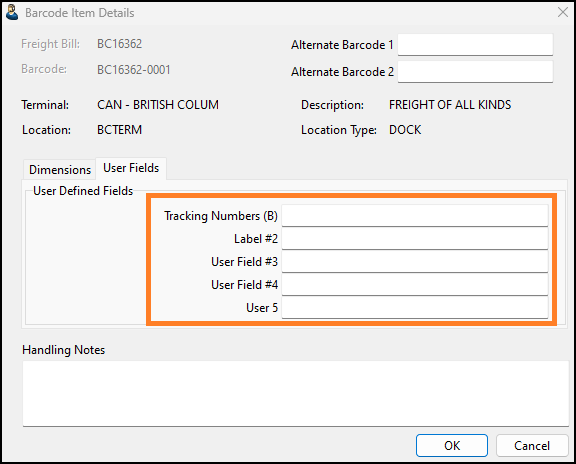
-
Set up the user field labels and field types in Codes Maintenance on the User Fields Setup tab.

When an item is modified, the history of the user field is recorded in the Dimensional Changes History grid in the Barcode Item Details window.

Improved performance of UPDATELEGSUM (TM-179451)
The UPDATELEGSUM procedure in Multi Mode Dispatch has received performance improvements. These are back-end improvements, so you will see no user interface changes. However, you should see improved performance around these actions:
-
Creating freight bills with Auto Assign to Trip
-
Creating trips
-
Assigning freight bills to trips
-
Changing trip statuses
-
Optimizing trips
Improved performance of MMDISP_LOCATION_TLORDER (TM-179288)
The MMDISP_LOCATION_TLORDER procedure in Multi Mode Dispatch has received performance improvements. These are back-end improvements, so you will see no user interface changes. However, you should see improved performance around these actions:
-
Switching tabs
-
Split/merge bill scenarios
-
Trap workflows
-
Pallet Group workflows
-
Advanced Terminal Planning workflows
-
Unloading workflows
Removed terminal selection if only one terminal is available (TM-179484)
Previously, when a user opened Multi Mode Dispatch they were always prompted to select a terminal if they did not have a default terminal. However, this step is not necessary for users who only have one terminal.
Terminal selection now follows this logic:
-
If the user does not have access to any terminal, they get an error message when they open the application.
-
If the user has access to only one terminal, the application opens without prompting for a terminal.
-
If the user has access to more than one terminal (and does not have a default terminal), the user is prompted to select a terminal.
ConnectedDock
Improved workflows to make sure haptics function (TM-178946, TM-178950, TM-178951, TM-178952, TM-178953)
Not all errors that appeared on a device were properly accompanied by a vibration. This issue has been fixed for these areas of ConnectedDock:
-
Unload locations
-
Manual search on Load screen
-
Manual search on Unload screen
-
Quick Unload location screen
-
Ad Hoc locations
CipherLab RS36, RS38, and RK95 certification (TM-178957, TM-178958, TM-178959)
These devices have been certified for use with ConnectedDock:
-
CipherLab RS36
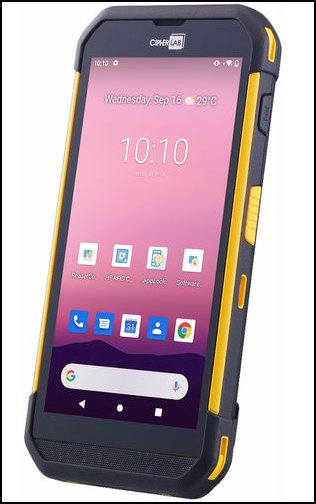
-
CipherLab RS38
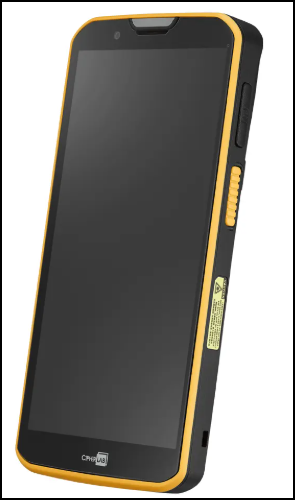
-
CipherLab RK95
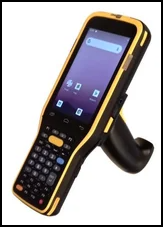
Using these devices requires the cipherLabsRelease APK. This is included in TruckMate’s APK package. To access the APK package, run the ConnectedDock application from your TruckMate folder.
Improved 500 error responses (TM-179363, TM-179364, TM-179365, TM-179366, TM-179369)
ConnectedDock is driven by APIs. Because of this, errors that occur should usually be a 400-series error. However, there were several instances where 500 errors were being reported instead.
These instances have been fixed so the correct error is reported both in ConnectedDock itself and within the ART server.
User field setup migration
Most user fields used to be managed by app configs. The management of many of these user fields has been migrated to Codes Maintenance. These user fields are now managed on the User Fields tab of Codes Maintenance instead of through app configs.
Any text you had in these app configs has been migrated into these user field tables. The app configs that were migrated have been removed.
For more information about user field setup, see User Fields.
These user fields are now managed in Codes Maintenance:
AP_PO (TM-177640)
The AP_PO table replaces the User Field app configs that were on the APPO.EXE tab in Application Configurator.

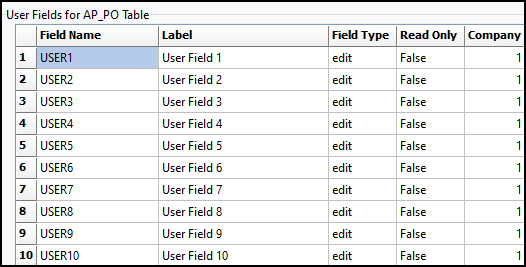
CLAIM (TM-177646)
The CLAIM table replaces the User Field app configs that were on the CLAIM.EXE tab in Application Configurator.

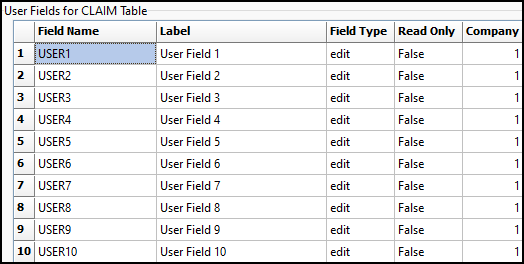
ACHARGE_CODE (TM-177647)
The ACHARGE_CODE table replaces the Accessorial Charge User Field app configs that were on the CODES.EXE tab in Application Configurator.

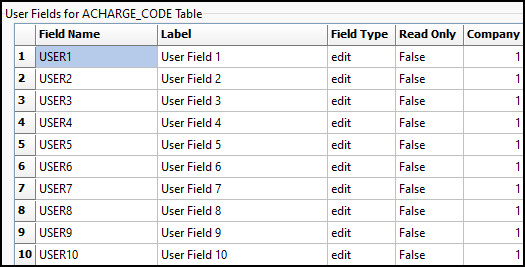
CMODTY (TM-177648)
The CMODTY table replaces the User Field app configs that were on the CODES.EXE tab in Application Configurator.

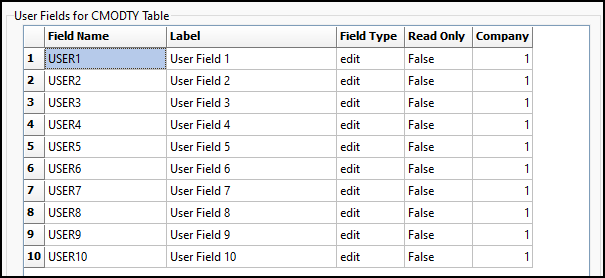
SITE (TM-177649)
The SITE table replaces the Site User Field app configs that were on the CODES.EXE tab in Application Configurator.

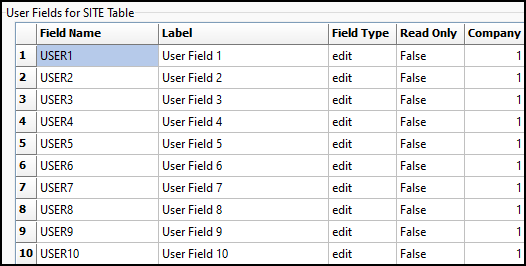
CD_INGATE_OUTGATE (TM-177650)
The CD_INGATE_OUTGATE table replaces the User Field app configs that were on the CONINV.EXE tab in Application Configurator.

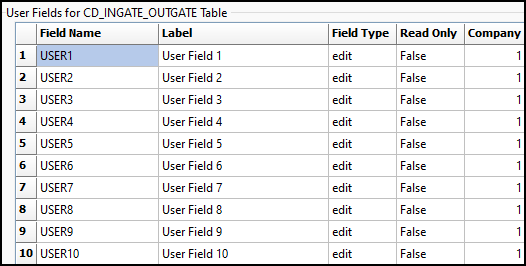
CONTAINER (TM-175152, TM-177651)
The CONTAINER table replaces the User Field and RM User Field app configs that were on the CONTAINERS.EXE tab in Application Configurator.

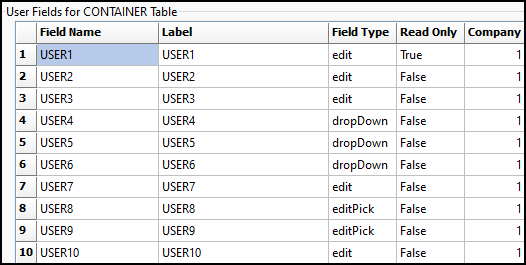

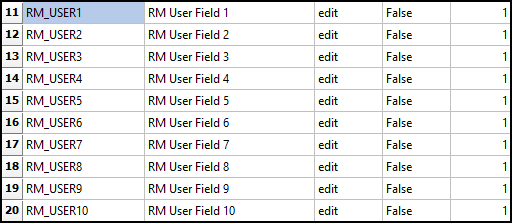
ACHARGE_TLORDER (TM-177655, TM-178516)
The ACHARGE_TLORDER table does not replace any pre-existing app configs.

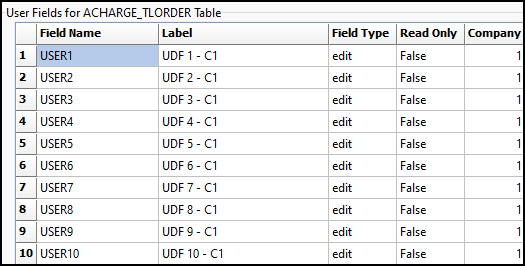


TLORDER_CUSTOMS (TM-177653)
The TLORDER_CUSTOMS table replaces the Customs User Field app configs that were on the CSERV.EXE tab in Application Configurator.

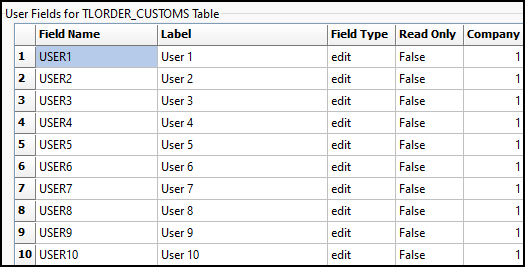
CONTAINER_TLORDER (TM-177656, TM-177657, TM-177658)
The CONTAINER_TLORDER table replaces the IM User Double, IM User Integer, and IM User String app configs that were on the CSERV.EXE tab in Application Configurator.





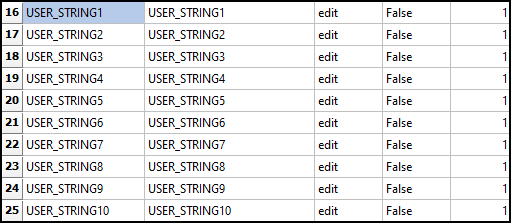
TLDTL (TM-177660)
The TLDTL table replaces the Load Detail User Field app configs that were on the CSERV.EXE tab in Application Configurator.

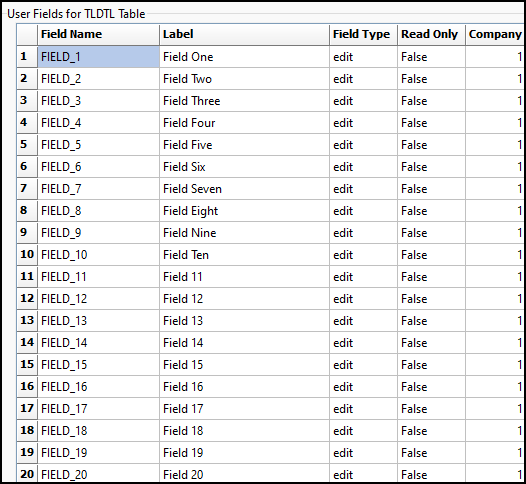
TRACE (TM-177663)
The TRACE table replaces the Trace User Field app configs that were on the CSERV.EXE tab in Application Configurator.

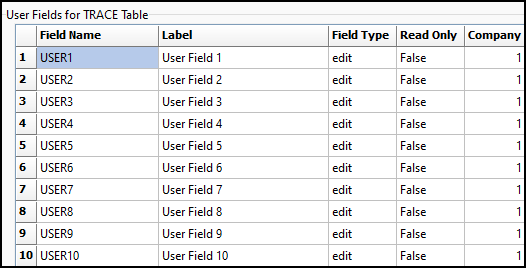
PALLET_TRANSFER (TM-177668)
The PALLET_TRANSFER table replaces the User Field app configs that were on the DPE.EXE tab in Application Configurator.

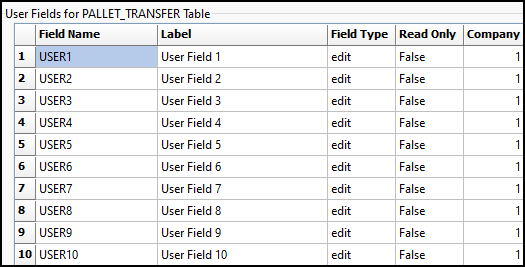
DRIVER (TM-175153)
The DRIVER table replaces the User Field and RM User Field app configs that were on the DRIVERS.EXE tab in Application Configurator.

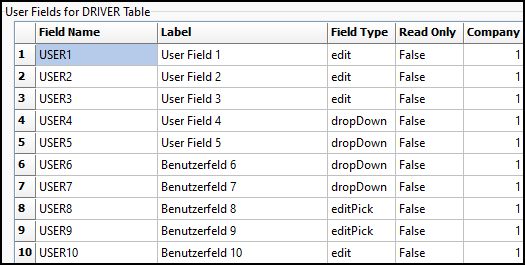
DRIVER_USERFIELDS (TM-177671)
The DRIVER_USERFIELDS table replaces the RM User Field app configs that were on the DRIVERS.EXE tab in Application Configurator.

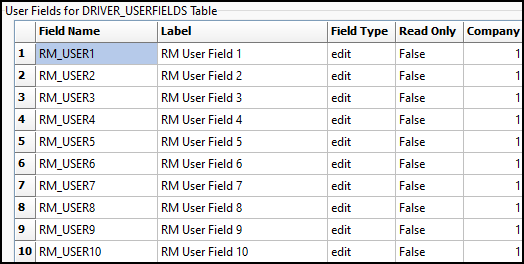
EMPLOYEE_USERFIELDS (TM-177672)
The EMPLOYEE_USERFIELDS table replaces the User Field app configs that were on the EMPLOYEE.EXE tab in Application Configurator.

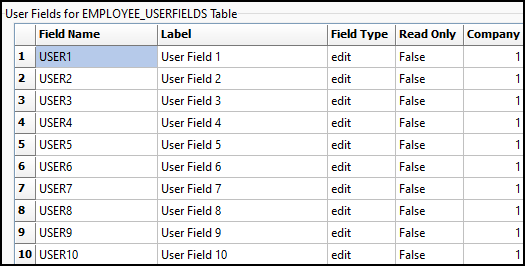
EQUIP (TM-175154, TM-177673)
The EQUIP table replaces the User Field and RM User Field app configs in EQUIP.EXE tab in Application Configurator.

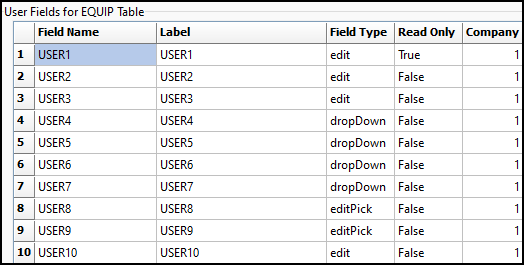

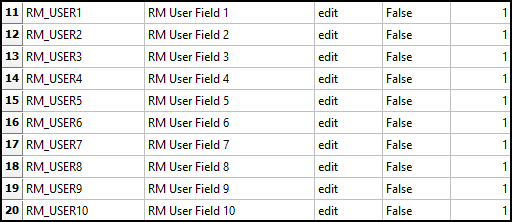
FA (TM-177674)
The FA table replaces the User Field app configs that were on the FA.EXE tab in Application Configurator.

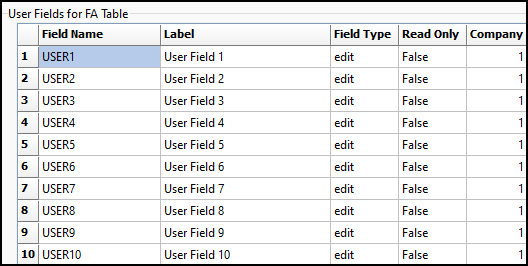
FLEET (TM-177675)
The FLEET table replaces the User Field app configs that were on the FLEET.EXE tab in Application Configurator.

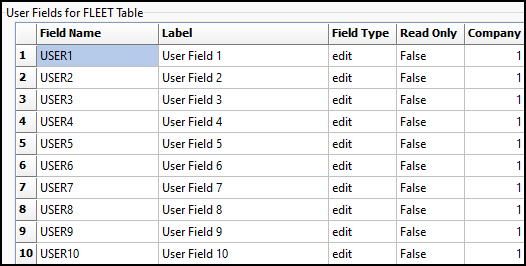
DRV_DEDCODES (TM-177680)
The DRV_DEDCODES table replaces the Deduction Code User app configs that were on the PAYCON.EXE tab in Application Configurator.

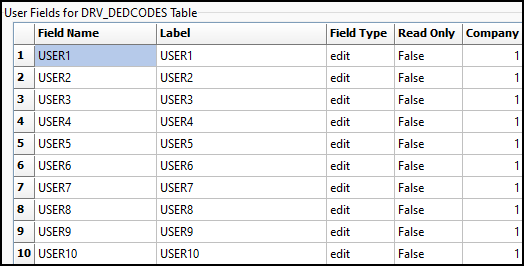
DRV_RULE_STOPS_USERFIELDS (TM-177681)
The DRV_RULE_STOPS_USERFIELDS table replaces the Driver Rule Stops User Field x label app configs that were on the PAYCON.EXE tab in Application Configurator.

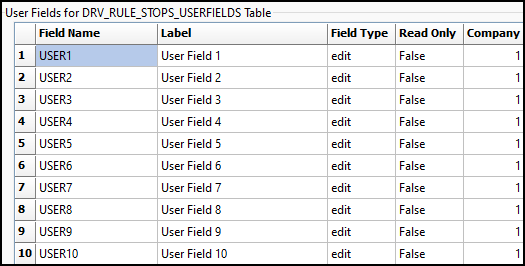
DRV_PAYCODES (TM-177683)
The DRV_PAYCODES table replaces the Pay Code User app configs that were on the PAYCON.EXE tab in Application Configurator.

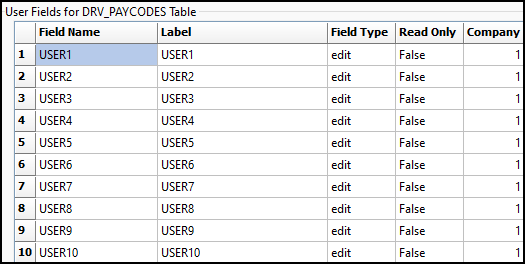
PUNIT (TM-175155, TM-177687)
The PUNIT table replaces the User Field and RM User Field app configs that were on the PUNIT.EXE tab in Application Configurator.

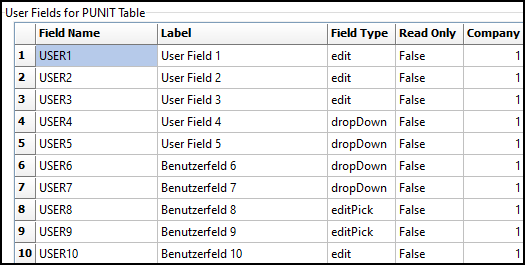

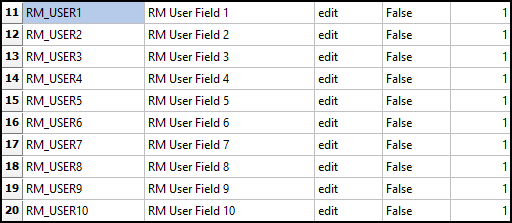
RM_OUTSIDE_EQUIP (TM-177688)
The RM_OUTSIDE_EQUIP table replaces the OS Equip User app configs that were on the RMCONFIG.EXE tab in Application Configurator.

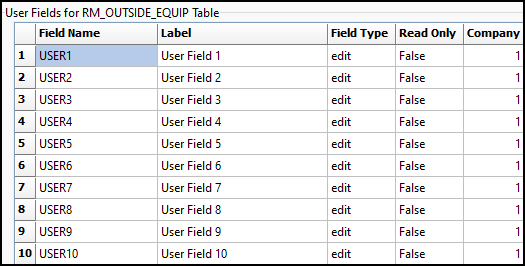
RM_PART (TM-177689, TM-177690)
The RM_PART table replaces the Part User Field and Part User Number app configs that were on the RMCONFIG.EXE tab in Application Configurator.

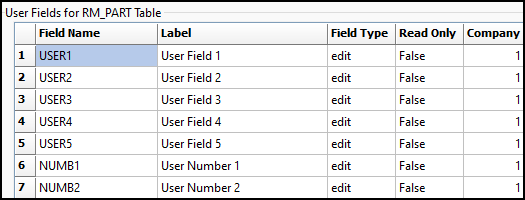
RM_WORKORDER (TM-177691)
The RM_WORKORDER table replaces the User Field app configs that were on the RMWO.EXE tab in Application Configurator.

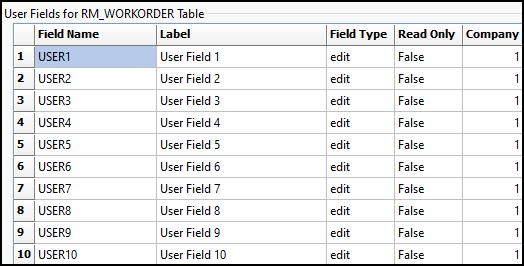
SCV_INCIDENT_INFO (TM-177692)
The SCV_INCIDENT_INFO table replaces the Incident User Field app configs that were on the SAFETY.EXE tab in Application Configurator.

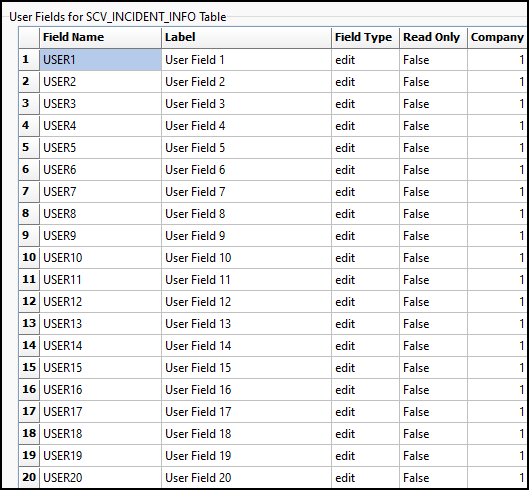
TANK_WASH (TM-177698)
The TANK_WASH table replaces the User app configs that were on the TANKWASH.EXE tab in Application Configurator.

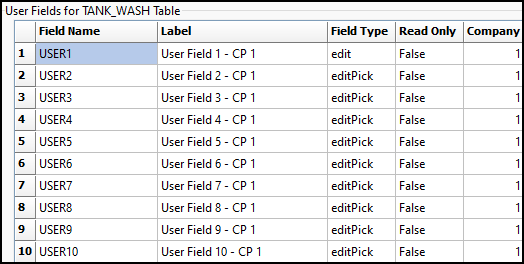
TLORDER (TM-175156)
The TLORDER table replaces the User Field app configs that were on the CSERVE.EXE tab in Application Configurator.

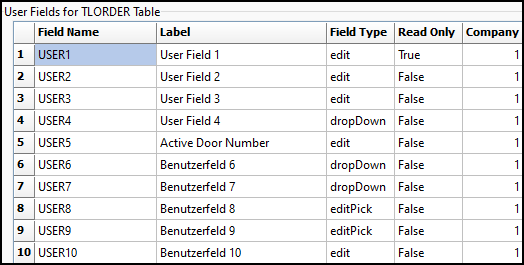
TRAILER (TM-175157, TM-177700)
The TRAILER table replaces the User Field and RM User Field app configs that were on the TRAILER.EXE tab in Application Configurator.

